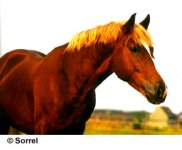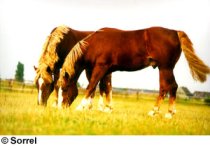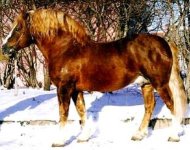♘امیرحسین♞
♘ مدیریت انجمن اسب ایران ♞
The breeding of a small draft horse which was strong, sufficiently fast, easy to keep and economical as regards management and feeding, went on in Russia concurrently with the breeding of a large heavy draft breed. The genetic material for the breed came from native Ukrainian breeds, the mountain Ardennes and, in part, from the Brabancon and the Orlov Trotter.
Systematic breeding began in the 1860s. The main nucleus of the breed was formed at Peter's Academy (now the K. Timiryazev Moscow Agricultural Academy), Chesma stud in Voronezh region, at Kochubei and Chaplits studs in Poltava region and Derkulski stud in the Ukraine. Meanwhile, grading up of native horses with the Ardennes was taking place. In 1875 there were nine Ardennes stallions in Russia; the number rose to 597 by 1915. By the beginning of the 20th century the Ardennes type became the most popular in Russia. Even in regions where there was a demand for large heavy drafts and were high grade Ardennes were mated with Brabancons, the crosses retained the old denomination of Ardennes. During the breed formation period, a role of particular importance was played by two breeding centers, the Chesma and the Dubrovsk, and subsequently by the Pershino and Khrenov studs. By the beginning of the 20th century, the world's zootechnical public was introduced to the Russian Heavy Draught at the 1900 Paris Exhibition. However, the First World War, followed by the Civil War, just about wiped the breed out. In 1924, only92 Ardenne stallions were found. In 1923, breeding animals at Dubrovsk stud were moved to Novoalexandrov stud in Voroshilovgrad region, while the Khrenov stud stock was moved first to Pershino and subsequently to Uralsk and Kuedin studs. By the year 1937 the stock of purebreds was reconstituted and isolated an independent breed.
Due to its high-profit feeding and high adaptability, the Russian Heavy Draught became quite widespread. It is now bred in the Ukraine and North Caucasus, in Udmurtia and Byelorussia, in Kirov, Sverdlovsk, Perm, Vologda and Archangel regions and in western Siberia.
The horse is not large yet heavily muscled; its trunk is long and broad; the joints are well developed and the limbs solid. The average measurements (in cm) of stud stallions are: heights at withers 152, oblique body length 161, chest girth 200 and cannon bone girth 22.5; mares: 149, 158, 192 and 21.2 respectively. The stallions' live weight is 600-700 kg; that of mares is 550-600 kg. The characteristic features are as follows: the head is average size, clean cut, with Oriental breediness; the forehead is wide and the profile is straight. The neck is short, broad, fleshy and high crested in stallions. The withers are low and broad; the back is long, broad, often somewhat soft; the croup is long, drooping; the loin is flat. The chest is deep and broad; the ribs are steeply sloping. The front legs are short, set too far apart; the pasterns are sometimes short and ringboned. The knee-joints are often too far back. The commonest color is chestnut; brown and bay are rarer.
The Russian Heavy Draught horse is strong, shows a fair speed and has a very willing disposition. The 2000 m draft walking record with a pull of 150 kg is 15 min 5 sec; the 2000 m trotting record with a pull of 300 kg is 1091m. The maximum pull record is 820 kg 117% of live weight.
The Russian Heavy Draught horse matures early; by weaning, the foals reach 250 kg. The mares are good milk producers. At koumiss farms mares produce up to 25000 kg of marketable milk in 6-7 months of lactation. The record milk yield is 5540 kg. Russian Draught horses can be used for periods of up to 25 years. They also have good fertility and longevity. The stallion Kolodnik (b. 1952) was used for breeding up to 1978, while the mare Logika (b. 1962) in 18 years of reproduction produced 18 foals, remains in good health and is still fertile.
The breed's structure includes 2 intra-breed types, the Ural and the Ukrainian, and 6 male lines. One new line is being formed.
The transferrin polymorphism has been studied in 862 horses and the allele frequency is as follows: D 0.33, F 0.31, H 0.01, R 0.27.
Systematic breeding began in the 1860s. The main nucleus of the breed was formed at Peter's Academy (now the K. Timiryazev Moscow Agricultural Academy), Chesma stud in Voronezh region, at Kochubei and Chaplits studs in Poltava region and Derkulski stud in the Ukraine. Meanwhile, grading up of native horses with the Ardennes was taking place. In 1875 there were nine Ardennes stallions in Russia; the number rose to 597 by 1915. By the beginning of the 20th century the Ardennes type became the most popular in Russia. Even in regions where there was a demand for large heavy drafts and were high grade Ardennes were mated with Brabancons, the crosses retained the old denomination of Ardennes. During the breed formation period, a role of particular importance was played by two breeding centers, the Chesma and the Dubrovsk, and subsequently by the Pershino and Khrenov studs. By the beginning of the 20th century, the world's zootechnical public was introduced to the Russian Heavy Draught at the 1900 Paris Exhibition. However, the First World War, followed by the Civil War, just about wiped the breed out. In 1924, only92 Ardenne stallions were found. In 1923, breeding animals at Dubrovsk stud were moved to Novoalexandrov stud in Voroshilovgrad region, while the Khrenov stud stock was moved first to Pershino and subsequently to Uralsk and Kuedin studs. By the year 1937 the stock of purebreds was reconstituted and isolated an independent breed.
Due to its high-profit feeding and high adaptability, the Russian Heavy Draught became quite widespread. It is now bred in the Ukraine and North Caucasus, in Udmurtia and Byelorussia, in Kirov, Sverdlovsk, Perm, Vologda and Archangel regions and in western Siberia.
The horse is not large yet heavily muscled; its trunk is long and broad; the joints are well developed and the limbs solid. The average measurements (in cm) of stud stallions are: heights at withers 152, oblique body length 161, chest girth 200 and cannon bone girth 22.5; mares: 149, 158, 192 and 21.2 respectively. The stallions' live weight is 600-700 kg; that of mares is 550-600 kg. The characteristic features are as follows: the head is average size, clean cut, with Oriental breediness; the forehead is wide and the profile is straight. The neck is short, broad, fleshy and high crested in stallions. The withers are low and broad; the back is long, broad, often somewhat soft; the croup is long, drooping; the loin is flat. The chest is deep and broad; the ribs are steeply sloping. The front legs are short, set too far apart; the pasterns are sometimes short and ringboned. The knee-joints are often too far back. The commonest color is chestnut; brown and bay are rarer.
The Russian Heavy Draught horse is strong, shows a fair speed and has a very willing disposition. The 2000 m draft walking record with a pull of 150 kg is 15 min 5 sec; the 2000 m trotting record with a pull of 300 kg is 1091m. The maximum pull record is 820 kg 117% of live weight.
The Russian Heavy Draught horse matures early; by weaning, the foals reach 250 kg. The mares are good milk producers. At koumiss farms mares produce up to 25000 kg of marketable milk in 6-7 months of lactation. The record milk yield is 5540 kg. Russian Draught horses can be used for periods of up to 25 years. They also have good fertility and longevity. The stallion Kolodnik (b. 1952) was used for breeding up to 1978, while the mare Logika (b. 1962) in 18 years of reproduction produced 18 foals, remains in good health and is still fertile.
The breed's structure includes 2 intra-breed types, the Ural and the Ukrainian, and 6 male lines. One new line is being formed.
The transferrin polymorphism has been studied in 862 horses and the allele frequency is as follows: D 0.33, F 0.31, H 0.01, R 0.27.



